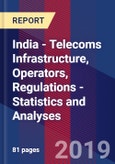Sweeping reforms introduced by successive Indian governments over the last two decades have dramatically changed the nature of telecommunications in India. The Indian government has been proactive in its efforts to transform India into a global telecommunication hub.
The mobile market continues to be the main focus of the Indian telecom sector. India's mobile market continues to get the bulk of local capital expenditure as the operators expand their infrastructure.
India has the potential to become one of the five largest data centre markets globally. In the last few years, there has been a radical shift in the way Indians produce and consume data. A number of government initiatives and regulations will see further increased in internet users and enforce strict data residency laws that will require vastly more data centre capacity. There will a rapid increase in the rate in which on-premise facilities are being outsourced to third-party data centres, as the cloud computing, especially cloud computing continues to grow.
India has a huge national telecommunications network. A strong increase in telecom subscribers base has necessitated network expansion covering a wider area, thereby creating a need for significant investment in telecom infrastructure.
Indias telecom industry is expected to see a major expansion of its network infrastructure during the 2019 to 2022 period. Each of the top three mobile operators: Reliance Jio, Airtel and Vodafone-Idea are now planning to extend coverage to address a surge in data consumption.
The fixed line market in India remains highly underdeveloped due to the dominance of the mobile segment. Further, the number of fixed telephone lines is slowly declining as the mobile segment continues to expand.
As well as its huge national network, India's investment in telecommunications infrastructure over the last decade has extended to a heavy involvement in the international market. Under the leadership of international operator VSNL/Tata Indicom the country has been assembling an extensive infrastructure of gateways, satellite earth stations and fibre optic submarine cables.
Key developments:
Companies mentioned in this report:
Aircel, Bharti Airtel, Loop Mobile (BPL Mobile), Vodafone Idea, Reliance Communications, Tata Teleservices, Videocon, S Tel, Bharti Telenet, Reliance Infocomm, Tata Teleservices.
The mobile market continues to be the main focus of the Indian telecom sector. India's mobile market continues to get the bulk of local capital expenditure as the operators expand their infrastructure.
India has the potential to become one of the five largest data centre markets globally. In the last few years, there has been a radical shift in the way Indians produce and consume data. A number of government initiatives and regulations will see further increased in internet users and enforce strict data residency laws that will require vastly more data centre capacity. There will a rapid increase in the rate in which on-premise facilities are being outsourced to third-party data centres, as the cloud computing, especially cloud computing continues to grow.
India has a huge national telecommunications network. A strong increase in telecom subscribers base has necessitated network expansion covering a wider area, thereby creating a need for significant investment in telecom infrastructure.
Indias telecom industry is expected to see a major expansion of its network infrastructure during the 2019 to 2022 period. Each of the top three mobile operators: Reliance Jio, Airtel and Vodafone-Idea are now planning to extend coverage to address a surge in data consumption.
The fixed line market in India remains highly underdeveloped due to the dominance of the mobile segment. Further, the number of fixed telephone lines is slowly declining as the mobile segment continues to expand.
As well as its huge national network, India's investment in telecommunications infrastructure over the last decade has extended to a heavy involvement in the international market. Under the leadership of international operator VSNL/Tata Indicom the country has been assembling an extensive infrastructure of gateways, satellite earth stations and fibre optic submarine cables.
Key developments:
- The adoption of the Internet of Things (IoT) in India has been advancing slowly with Indian enterprises.
- India has the potential to become one of the five largest data centre markets globally.
- Indias telecom industry is expected to see a major expansion of its network infrastructure during the 2019 to 2022 period.
Companies mentioned in this report:
Aircel, Bharti Airtel, Loop Mobile (BPL Mobile), Vodafone Idea, Reliance Communications, Tata Teleservices, Videocon, S Tel, Bharti Telenet, Reliance Infocomm, Tata Teleservices.
Table of Contents
1 Key statistics9 Related Reports
2 Telecommunications Market
3 Regulatory Environment
4 Fixed Network Operators
5 Telecommunications Infrastructure
6 Data Centres
7 IT Specific Developments
8 Smart Infrastructure
List of Tables
List of Charts
Companies Mentioned
- Aircel
- Bharti Airtel
- Loop Mobile (BPL Mobile)
- Vodafone Idea
- Reliance Communications
- Tata Teleservices
- Videocon
- S Tel
- Bharti Telenet
- Reliance Infocomm
- Tata Teleservices.








